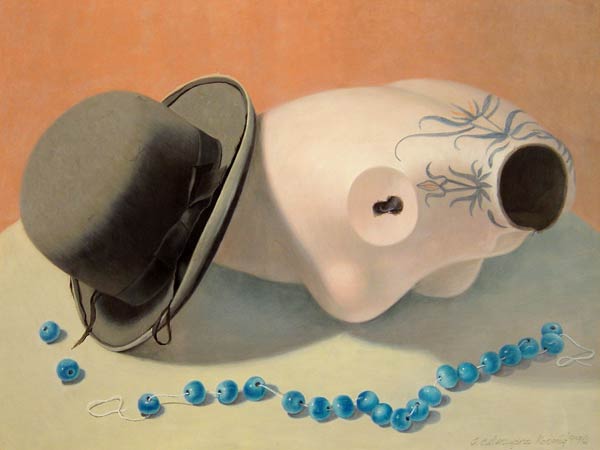Catherine Koenig: The Woman and the Bowler Hat
by Dean Brownrout

Something Blue by Catherine Catanzaro Koenig. Used with permission of the Koenig family.
|
A woman of extraordinary talent, Buffalo-born artist Catherine Koenig (nee Catanzaro) (1921-2004) is remembered best for her realistic still-life paintings incorporating surrealist iconography.
Koenig displayed a talent for art early on. After high school, she studied at the Albright Art School. It was a seminal period in the Buffalo institution’s history. She developed her craft under such esteemed faculty as Ralston Crawford, Charles Burchfield, Philip Elliott, and Isaac Soyer. She graduated in 1942.
At that time, Koenig exhibited her work regularly around town, including shows at the renowned Western New York Exhibitions held at the Albright Art Gallery. In 1946, she began teaching at the Art Institute of Buffalo. She married fellow artist James Koenig in 1947.
By the 1950s, she was featured in group exhibits throughout the northeast that included the Brooklyn Museum, the Pennsylvania Academy of the Fine Arts, and the Butler Institute of American Art in Youngstown, Ohio.
Koenig’s preferred medium for painting was egg tempera. Egg tempera is a complicated and time-consuming method using egg yolk, water, and pigment to create paint. Tempera was the primary medium of most painters of the Italian Renaissance, including da Vinci and Michelangelo. The form, which had fallen out of favor, found revival in the twentieth century. Artists such as Giorgio de Chirico and Thomas Hart Benton worked with tempera.
According to an oft-cited story, Koenig purchased a used bowler hat for her husband to wear to a costume ball, where he dressed as Charlie Chaplin’s Little Tramp. The hat sat around her studio for years until one day, in the late 1970s, she looked at it and thought, “Magritte!” She began a series of paintings referencing the bowler and the Belgian surrealist René Magritte, who had often incorporated such a hat.
From this point forward, her sublimely rendered paintings often pay homage to the early surrealist movement, with the inclusion of images like clear blue skies, headless mannequins, or broken eggshells. Yet, with their unique blend of realism, surrealism, and classicism, they are distinctly her own.
The 1980s and 1990s saw her exhibiting extensively throughout America, in both solo and group exhibitions. In 2002, she was awarded a prestigious grant from the Pollock-Krasner Foundation.
In 2003, the Burchfield-Penney Art Center and UB’s Anderson Gallery honored this remarkable artist’s inspiring body of work with simultaneous shows.
blog comments powered by Disqus|
Issue Navigation> Issue Index > v8n3 (week of Thursday, January 15, 2009) > Catherine Koenig: The Woman and the Bowler Hat This Week's Issue • Artvoice Daily • Artvoice TV • Events Calendar • Classifieds |









 Current Issue
Current Issue